What Causes Normal Straight Lines In A Camera To Become Exaggerated Moire
| Measuring Sharpness | Modulation Transfer Function | Spatial Frequency Units | Summary metrics | MTF Measurement Matrix | Slanted-edge |
|---|
On this page: Ascension Distance and Frequency Domain |Modulation Transfer Function | Spatial Frequency Units
Summary metrics | MTF measurement Matrix: comparing different charts and measurements
| Slanted-Edge measurement | Edge angles | Slanted-Edge modules
Edge dissimilarity and clipping | Slanted-Border algorithm | Differences with ISO | Noise reduction
Related sharpness techniques | Key takeaways | Additional resources
Measuring Sharpness
Sharpness determines the amount of particular an imaging system tin can reproduce. It is defined by the boundaries betwixt zones of dissimilar tones or colors.

Figure 1. Bar design: Original (upper half of figure) with lens deposition (lower half of figure)
In Figure 1, sharpness is illustrated with a bar pattern of increasing spatial frequency. The top portion of the figure is precipitous and its boundaries are well-baked; the lower portion is blurred and illustrates how the bar pattern is degraded later passing through a fake lens.
Note: All lenses blur images to some caste.
Sharpness is most visible on features like image edges (Figure 2) and can be measured by the edge (step) response.
Several methods are used for measuring sharpness that include the ten-ninety% rise distance technique, modulation transfer function (MTF), special and frequency domains, and slanted-edge algorithm.
Ascension Distance and Frequency Domain
Image sharpness can be measured by the "rise distance" of an edge within the image.
With this technique, sharpness tin be determined by the distance of a pixel level between x% to 90% of its final value (too called x-90% rise distance ; see Figure iii).
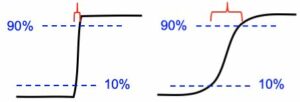
Figure 3. Illustration of the 10-90% rising distance on blurry and sharp edges
Rise distance is not widely used because there is no convenient way of calculating the rise altitude of an imaging system from the rise distances of its individual components (i.e., lens, digital sensor, and software sharpening).
To overcome this effect, measurements are made in the frequency domain where frequency is measured in cycles or line pairs per distance (millimeters, inches, pixels, image tiptop, or sometimes angle [degrees or milliradians]).
In the frequency domain, a complex indicate (audio or image) can be created past combining signals consisting of pure tones (sine waves), which are characterized by a catamenia or frequency (Figure 4). The response of a complete system is the product of the responses of each component.

Figure 4. Definition of Period (1/frequency)
Frequency and spatial domains are related by the Fourier transform.
- The greater the system response at high frequencies (brusque periods), the more item the system tin can convey (Effigy 5). Arrangement response tin be characterized by a frequency response curve, F(f).
Note: High frequencies correspond to fine detail.
Modulation Transfer Function

Figure v. High frequencies represent to fine detail in the spatial and frequency domains
The relative contrast at a given spatial frequency (output contrast/input contrast) is chosen Modulation Transfer Function ( MTF ) , which is similar to the Spatial Frequency Response (SFR), and is a key to measuring sharpness. In Figure half dozen, MTF is illustrated with sine and bar patterns, an aamplitude plot, and a dissimilarity plot—each of which has spatial frequencies that increase continuously from left to correct.
Annotation : Imatest uses SFR and MTF interchangeably. SFR is more than commonly associated with consummate arrangement response, where MTF is unremarkably associated with the private furnishings of a particular component. In other words, organisation SFR is equivalent to the product of the MTF of each component in the imaging system.
High spatial frequencies (on the correct) correspond to fine paradigm detail. The response of photographic components (film, lenses, scanners, etc.) tends to "roll off" at high spatial frequencies. These components can be thought of as depression-laissez passer filters that pass depression frequencies and attenuate high frequencies.
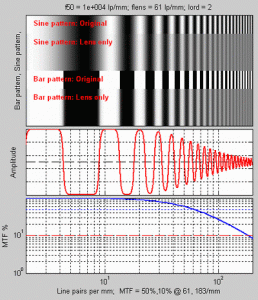
Figure half-dozen. Sine and bar patterns, amplitude plot, and Contrast (MTF) plot
Figure half dozen consists of upper, middle, and lower plots and are described every bit follows:
- Bar pattern, Sine pattern (upper plot) —The upper plot illustrates (1) the original sine patterns, (2) the sine blueprint with lens blur, (3) the original bar blueprint, and (4) the bar pattern with lens mistiness. Note that lens mistiness causes contrast to drop at loftier spatial frequencies.
- Amplitude (middle plot) —The middle plot displays the luminance ("modulation" V in the MTF Equation section) of the bar design with lens blur (see red curve in Figure 6). The modulation of the sine pattern, which consists of pure frequencies, is used to summate MTF. (Note that c ontrast decreases at loftier spatial frequencies.)
- MTF % (lower plot) —The lower plot shows the corresponding sine pattern contrast (see blueish curve; represents MTF), which likewise is defined in the MTF Equation section. By definition, the low frequency MTF limit is always 1 (100%). In Figure 6, the MTF is 50% at 61 lp/mm (line pairs per millimeter) and x% at 183 lp/mm. Note that b oth frequency and MTF are displayed on logarithmic scales with exponential annotation [100 = one%; xane = 10%; 102 = 100%, etc.]; amplitude (middle plot) is displayed on a linear scale. The MTF of a complete imaging organisation is the production of the MTF of its individual components.
MTF Equation
The equation for MTF is derived from the sine blueprint dissimilarityC(f) at spatial frequencyf, where
\(\displaystyle C(f)=\frac{V_{max}-V_{min}}{V_{max}+V_{min}}\)for luminance ("modulation")V.
\(\displaystyle MTF(f)=100\% \times\frac{C(f)}{C(0)}\) Note : this normalizes MTF to 100% at low spatial frequencies.
To correctly normalize MTF at low spatial frequencies, a test chart must have some low-frequency energy. This is supplied by large light and dark areas in slanted edges and past features in most patterns used by Imatest, but is not present in lines and grids. For systems where sharpening tin be controlled, the recommended principal MTF calculation is the slanted-edge, which is calculated from the Fourier transform of the impulse response (i.e., response to a narrow line), which is the derivative (d/dx or d/dy) of the border response. Fortunately, you don't need an understanding of Fourier transforms to understand MTF.
Traditional Resolution Measurements
Traditional resolution measurements involve observing an prototype of bar patterns, most oft the USAF 1951 chart (Effigy 7) and estimating the highest spatial frequency (lp/mm) where bar patterns are visibly distinct. This ascertainment (besides called vanishing resolution ) corresponds to an MTF of roughly ten-20%. Because the vanishing resolution is the spatial frequency where image information disappears — where information technology isn't visible , information technology is strongly dependent on observer bias and is a poor indicator of image sharpness. (It'southward Where the Woozle Wasn't in Winnie the Pooh.)
Note : The USAF 1951 nautical chart (long-since abandoned by the Air Force) is poorly suited for computer assay because information technology uses space inefficiently and its bar triplets lack a depression frequency reference. Furthermore, minor alter s in chart position (sampling stage) tin cause the advent of its confined to change as they shift from being in stage to out of stage with the pixel array. This adversely affects the vanishing resolution gauge.
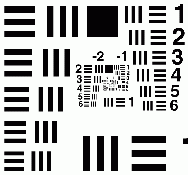
Figure vii. USAF 1951 chart; not supported past Imatest
Better indicators of image sharpness are spatial frequencies where MTF is 50% of its low frequency value (MTF50) or 50% of its peak value (MTF50P). MTF50 and MTF50P are recommended for comparing the sharpness of different cameras and lenses because
- Paradigm contrast is half its low frequency or peak value thus detail is still quite visible. (The centre is insensitive to detail at spatial frequencies where MTF is 10% or less.)
- The response of nearly cameras falls off rapidly in the vicinity of MTF50 and MTF50P. MTF50P is a better metric for strongly sharpened cameras (explained in our paper from Electronic Imaging 2020).
- The 50% level is related to the image's information capacity.
Annotation : Boosted sharpness indicators are discussed in Summary metrics, below.
Although MTF can exist estimated directly from images of sine patterns (using Rescharts, Log Frequency , Log F-Contrast , and Star Chart ), the ISO 12233 slanted-edge technique provides more accurate and repeatable results and uses space more efficiently. Slanted-edge images can be analyzed by 1 of the modules listed in the MTF Measurement Matrix, below .
Spatial Frequency Units
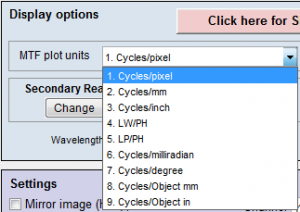
Figure 8. Spatial frequency units are selected in the Settings or More than settings windows of SFR and Rescharts modules (SFRplus, eSFR ISO, Star, etc.).
Almost readers will be familiar with temporal frequency. For example, the frequency of a sound—measured in Cycles/Second or Hertz —is closely related to its perceived pitch. The frequencies of radio transmissions (measured in kilohertz, megahertz, and gigahertz) are also familiar.
Spatial frequency is measured in cycles (or line pairs) per distance instead of fourth dimension. As with temporal (e.thou., audio) frequency response, the more extended the response, the more than item can be conveyed.
Spatial frequency units can be selected from the Settings or More settings windows of SFR and Rescharts modules (SFRplus, eSFR ISO, Star, etc. Figure viii) and is the measurement intended to determine how much detail a camera can reproduce or how well the pixels are utilized.
Past pic camera lens tests used line pairs per millimeter (lp/mm), which worked well for comparison lenses considering most 35mm motion picture cameras have the same 24 x 36mm picture size. Simply digital sensor sizes vary widely—from under 5mm diagonal in camera phones to 43mm diagonal for total-frame cameras to an even larger diagonal for medium format. For this reason, line widths per picture height (LW/PH) is recommended for measuring the total detail a photographic camera tin reproduce. Note that LW/PH is equal to two × lp/mm × (movie top in mm).
Another useful spatial frequency unit is cycles per pixel (C/P), which gives an indication of how well individual pixels are utilized. The choice of units is as well influenced past whether performance at the image (sensor) or on the object has primary importance: come across Comparing sharpness in dissimilar cameras. In that location is no need to use actual distances (millimeters or inches) with digital cameras, although such measurements are available (Table 1).
Table 1. Summary of spatial frequency units with equations that refer to MTF in selected frequency units.
| MTF Unit | Application | Equation |
| Cycles/Pixel (C/P) | Shows how well pixels are utilized. Nyquist frequency f Nyq is always 0.five C/P. | |
| Cycles/Distance (cycles/mm or cycles/inch) | Cycles per altitude on the sensor. Pixel spacing or pitch must be entered. Popular for comparing resolution in the one-time days of standard picture formats (e.thousand., 24x36mm for 35mm movie). | \(\frac{MTF(C/P)}{\text{pixel pitch}}\) |
| Line Widths/Picture Height (LW/PH) note: for cropped images enter the original picture top into the more settings dimensions input | Measures overall image sharpness. This is the best unit for comparison the performance of cameras with different sensor sizes and pixel counts. Line Widths is traditional for Television receiver measurements. Recommended for prototype-centric applications in Comparing sharpness in different cameras. Note that 1 Bike = 1 Line Pair (LP) = ii Line Widths (LW). | \(2 \times MTF\bigl(\frac{LP}{PH}\bigr)\) ; \(2 \times MTF\bigl(\frac{C}{P}\bigr) \times PH\) |
| Line Pairs/Picture Superlative (LP/PH) note: for cropped images enter the original picture height into the more than settings dimensions input | Measures overall prototype sharpness. Differs from LW/PH by a factor of 2. Used by dpreview.com. | \(MTF\bigl(\frac{LW}{PH}\bigr) / 2\) ; \(MTF\bigl(\frac{C}{P}\bigr) \times PH\) |
| Angular frequency Cycles/milliradian | Athwart frequencies. Pixel spacing or pitch must be entered. Focal length (FL) in mm is normally included in EXIF data in commercial image files. If information technology isn't available it must be entered manually, typically in the EXIF parameters region at the bottom of the settings window. If pixel spacing or focal length is missing, units will default to Cycles/Pixel. FL can be calculated from the simple lens equation*, \(1/FL = one/s_1 + i/s_2\), where s 1 is the lens-to-nautical chart altitude (easy to measure out), s 2 is the lens-to-sensor distance, and magnification \(Grand = s_2/s_1\). \(FL = s_1/(1+1/|M|)\ =\ s_2/(ane+|M|)\) *Unless s 1 >> s ii, (by 100× or more), lens geometry (s 1, s 2, and FL) is non reliable for calculating Yard considering lenses can deviate significantly from the simple lens equation. | \(0.001 \times MTF\bigl(\frac{\text{cycles}}{\text{mm}}\bigr) \times FL(\text{mm})\) |
| Cycles/caste | \(\frac{\pi}{180} \times MTF\bigl(\frac{\text{cycles}}{\text{mm}}\bigr) \times FL(\text{mm})\) | |
| Cycles/object mm | Cycles per distance on the object existence photographed (what some people recall of as the "subject"). Pixel spacing and magnification must exist entered with an important exception*. Should be used when the organization specification references the object being photographed (for example, if features of a certain width need to be detected). Recommended for object-centric applications in Comparing sharpness in dissimilar cameras. *For SFRplus when bar-to-bar spacing is entered, eSFR ISO when the registration mark vertical spacing is entered, or Checkerboard when the square length is entered, Cycles per object distance is calculated directly without using pixel spacing or entering magnification, which is calculated from the geometry. Before Imatest 2021.2 you had to enter a number in the Pixel spacing field, but this number is not used for the bodily calculation. We apologize for the confusion. | \(MTF\bigl( \frac{\text{Cycles}}{\text{Altitude}} \bigr) \times |\text{Magnification}|\) Cycles/altitude is Cycles/mm or Cycles/in on the paradigm sensor. |
| Line Widths/Ingather Height | Primarily used for testing when the active chart height (rather than the total image elevation) is meaning. No longer recommended because information technology's dependent on the ingather size, which is not standardized. | |
| Line Widths/Characteristic Ht(Px) (formerly Line Widths or Line Pairs/North Pixels (PH)) | When either of these is selected, a Characteristic Ht pixels box appears to the right of the MTF plot units (sometimes used for Magnification) that lets you enter a feature summit in pixels, which could be the height of a monitor under test, a exam chart, or the agile field of view in an epitome that has an inactive area. This unit of measurement selection is useful for comparing the resolution of specific objects for cameras with different paradigm or pixel sizes. Recommended for object-centric applications in Comparing sharpness in different cameras. | \(2 \times MTF\bigl(\frac{C}{P}\bigr) \times \text{Feature Height}\) \(MTF\bigl(\frac{C}{P}\bigr) \times \text{Feature Elevation}\) |
| PH = Movie Height in pixels. FL(mm) = Lens focal length in mm.Pixel pitch = distance per pixel = 1/(pixels per distance). | ||
Comparison sharpness in different cameras recommends spatial frequency units based on ane of two wide types of application:
-
- Image-centric (such as landscape photography, where detail on the image sensor is important): Line Widths (or Pairs) per Picture Superlative is recommended.
- Object-axial (for medical, car vision, etc., where details of the object are of import): Cycles/object altitude or LW (or LP) per Feature Pinnacle are recommended.
Summary Metrics
Several summary metrics are derived from MTF curves to characterize overall performance. These metrics are used in a number of displays, including secondary readouts in the SFR/SFRplus/eSFR ISO Border/MTF plot (see Imatest Slanted-Edge Results) and in the SFRplus 3D maps.
| Summary Metric | Clarification | Comments |
| MTF50 MTFnn | Spatial frequency where MTF is 50% (nn%) of the low (0) frequency MTF. MTF50 (nn = l) is widely used considering it corresponds to bandwidth (the half-power frequency) in electric engineering. | The most common summary metric; correlates well with perceived sharpness. Increases with increasing software sharpening; may be misleading because information technology "rewards" excessive sharpening, which results in visible and mayhap annoying "halos" at edges. |
| MTF50P MTFnnP | Spatial frequency where MTF is 50% (nn%) of the peak MTF. | Identical to MTF50 for low to moderate software sharpening, only lower than MTF50 when there is a software sharpening peak (maximum MTF > one). Much less sensitive to software sharpening than MTF50 (equally shown in a newspaper we presented at Electronic Imaging 2020). All in all, a improve metric. |
| MTF area normalized | Area nether an MTF curve (below the Nyquist frequency), normalized to its peak value (1 atf = 0 when there is little or no sharpening, simply the peak may be » one for strong sharpening). | A particularly interesting new metric because it closely tracks MTF50 for little or no sharpening, merely does not increase for strong oversharpening; i.e., it does not reward excessive sharpening. Even so relatively unfamiliar. Described in Slanted-Edge MTF measurement consistency. |
| MTF10, MTF10P, MTF20, MTF20P | Spatial frequencies where MTF is 10 or 20% of the goose egg frequency or peak MTF | These numbers are of interest because they are comparable to the "vanishing resolution" (Rayleigh limit). Noise can strongly affect results at the 10% levels or lower. MTF20 (or MTF20P) in Line Widths per Film Superlative (LW/PH) is closest to analog Television receiver Lines. Details on measuring monitor TV lines are found here. |
MTF Measurement Matrix — comparing unlike charts and measurement techniques
Imatest has many patterns for measuring MTF— slanted-edge, Log frequency, Log f-contrast, Siemens Star, Expressionless Leaves (Spilled Coins), Random 1/f, and Hyperbolic wedge— each of which tends to requite different results in consumer cameras, nearly of which accept nonuniform prototype processing— ordinarily bilateral filtering — that depends on local scene content. Sharpening (high frequency heave) tends to be maximum near contrasty features (larger near college contrast edges), while noise reduction (high frequency cut, which can obscure fine texture) tends to be maximum in their absenteeism. For this reason MTF measurements can be very different with different test charts.
In principle, MTF measurements should be the same when no nonuniform or nonlinear image processing (bilateral filtering) is practical, for instance when the image is demosaiced with dcraw or LibRaw with no sharpening and noise reduction. Just this does not exactly happen considering demosaicing, which is present in all cameras that use Color Filter Arrays (CFAs) involves some nonlinear processing. The sensitivity of different patterns to image processing is summarized in the image below.
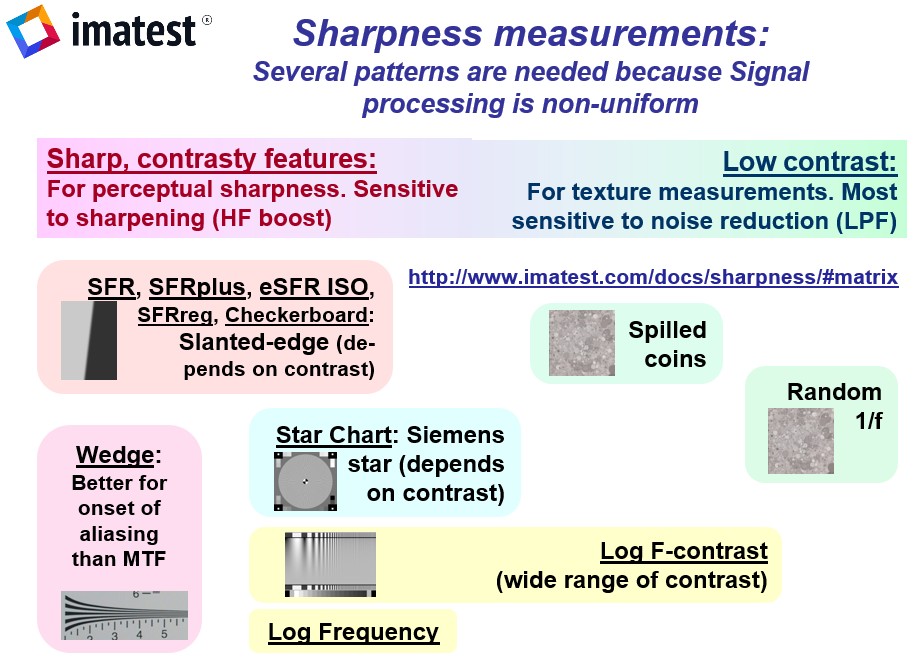 Comparison of the effects of epitome processing (bilateral filtering) on MTF measurements:
Comparison of the effects of epitome processing (bilateral filtering) on MTF measurements:
Slanted-edges and wedges tend to be sharpened the about.
The random i/f design has the least sharpening and the most noise reduction.
The MTF Matrix table below lists the attributes, advantages, and disadvantages of Imatest'due south methods for measuring MTF.
Slanted-Edge Measurement for Spatial Frequency Response
Several Imatest modules measure MTF using the slanted-border technique and include:
- Slanted-border test charts that may be purchased from Imatest or created with Imatest Test Charts . Charts that employ automatic detection ( SFRplus , eSFR ISO , SFRreg , or Checkerboard ) are recommended.
- Briefly, the ISO 12233 slanted-edge method calculates MTF past finding the boilerplate edge (4X oversampled using a clever binning algorithm ), differentiating it (to obtain the Line Spread Function (LSF)), and taking the absolute value of the Fourier transform of the LSF. The algorithm is described in detail hither.
The key output of slanted edge analysis is the Edge/MTF plot, which can exist viewed by clicking the button below. Many additional results are available, including summary and 3D plots, showing Lateral Chromatic Aberration and other results equally well as MTF.
Why is the edge slanted?
MTF results for pure vertical or horizontal edges are highly dependent on sampling stage (the human relationship between the edge and the pixel locations), and hence tin can vary from one run to the next depending on the precise (sub-pixel) edge position. The edge is slanted and so MTF is calculated from the boilerplate of many sampling phases, which makes results much more stable and robust (Figure ix ).
What edge angles work best?
Where possible, edge angles should be greater than ±two degrees from the closest Vertical (V), Horizontal (H), or 45 caste orientation. The reason is that results from vertical, horizontal, and 45° edges are very sensitive to the relationship between the edge and the pixels (i.due east., they are phase-sensitive). Tilting the edges by more than two or 3 degrees avoids this issue.
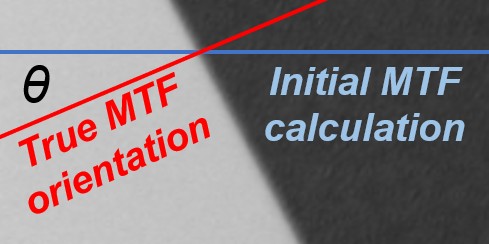 The ISO 12233 standard recommends an bending of either 5 or five.71 degrees (arctan(0.1)). This angle is not sacred— MTF is not strongly dependent on edge angle. Angles from 3 to 7 degrees piece of work fine. For nonzero edge angles θ relative to the closest V or H orientation, a cosine correction is applied, as illustrated on the right. The correction is significant when θ is greater than about 8 degrees (cos(8º) = 0.99). The initial MTF and corresponding frequency f are calculated from a Vertical or Horizontal line (shown in blue ), based on the region selection. The true MTF is defined normal to the border— along the cherry-red line. Since the length of the actual transition along the red line (normal to the border) is shorter than the measured transition along the blue (V or H) line , and since the frequency f used to measure MTF is inversely proportional to the bodily transition length,
The ISO 12233 standard recommends an bending of either 5 or five.71 degrees (arctan(0.1)). This angle is not sacred— MTF is not strongly dependent on edge angle. Angles from 3 to 7 degrees piece of work fine. For nonzero edge angles θ relative to the closest V or H orientation, a cosine correction is applied, as illustrated on the right. The correction is significant when θ is greater than about 8 degrees (cos(8º) = 0.99). The initial MTF and corresponding frequency f are calculated from a Vertical or Horizontal line (shown in blue ), based on the region selection. The true MTF is defined normal to the border— along the cherry-red line. Since the length of the actual transition along the red line (normal to the border) is shorter than the measured transition along the blue (V or H) line , and since the frequency f used to measure MTF is inversely proportional to the bodily transition length,
\(f=f_{initial} / cos(\theta)\)
Corresponding summary metrics MTFnn (MTF50, MTF50P, etc.), which have units of frequency, are increased over the initial values.
\(MTFnn = MTFnn(\text{initial}) / cos(\theta)\)
The primary disadvantage of large edge angles is that the available region expanse may be reduced, especially for SFRreg patterns.
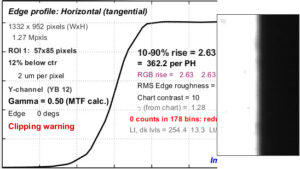
Figure 9. Clipped high-contrast vertical edge (results are not valid)
Edge Contrast and clipping
Border Contrast should exist express to 10:1 at the nearly, and a 4:1 border contrast is generally recommended. The reason is that loftier contrast edges (>10:1, such as found in the one-time ISO 12233:2000 chart) tin cause saturation or clipping, resulting in edges with precipitous corners that exaggerate MTF measurements. For more than details, see Using Rescharts slanted-edge modules, Role ii: Warnings – clipping.
Advantages and Disadvantages of Slanted Edge
Advantages
- Most efficient use of space, which makes it possible to create a detailed map of MTF response
- Fast, automated region detection in SFRplus , eSFR ISO , SFRreg , and Checkerboard
- Fast calculations
- Relatively insensitive to noise (highly immune if noise reduction is applied)
- Compliant with the ISO 12233 standard, whose "binning" (super-resolution) algorithm allows MTF to exist measured above the Nyquist frequency (0.five C/P)
- The all-time pattern for manufacturing testing
Disadvantages
- May give optimistic results in systems with strong image-dependent sharpening (i.e., where the amount of sharpening increases with edge dissimilarity). This type of image processing (bilateral filtering) is almost universal in consumer cameras.
- Gives inconsistent results in systems with extreme aliasing (strong energy above the Nyquist frequency), peculiarly with small regions.
- Not suitable for measuring fine texture, where the Log Frequency-Contrast or Spilled Coins (Dead Leaves) patterns are recommended.
Note : Imatest Principal can calculate MTF for edges of virtually any angle, though exact vertical, horizontal, and 45° should exist avoided because of sampling phase sensitivity.
Slanted-Edge Modules
Imatest Slanted-Edge Modules include SFR, SFRplus, eSFR ISO, Checkerboard, and SFRreg (run into Tabular array two and Sharpness Modules for details).
Note : Meet "How to test lenses with Imatest" for a proficient summary of how to measure MTF using SFRplus oreSFR ISO.
Table 2. Brief summary of Imatest slanted-edge modules.
Slanted-Edge Algorithm
The MTF adding is derived fromISO standard 12233. The Imatest calculation contains a number of enhancements, listed below. The original ISO calculation is performed when the ISO standard SFR checkbox in theSFR input dialog boxis checked (nosotros recommended leaving information technology unchecked unless information technology'south specifically required).
- The cropped image is linearized; i.due east., the pixel levels are adjusted to remove thegamma encoding practical by the camera. (Gamma is adjustable with a default of 0.5).
- The edge locations for the red, green, bluish, and luminance (Y) channels:
Y = 0.2125R + 0.7154G + 0.0721B (default) or 0.3R + 0.59G + 0.11B or (selectable in Options III)
are determined for each scan line (horizontal lines in the to a higher place paradigm). - A 2nd order fit to the border is calculated for each aqueduct using polynomial regression. The second order fit removes the furnishings of lens distortion. In the above prototype, the equation would have the course:
\(10 = a_0 + a_1y + a_2y^2\)
- Depending on the value of the fractional part of scan line i,
fp = xi – int(xi )
of the 2nd lodge fit at each scan line, the shifted border is added to one of 4 bins:
bin 1 if 0 ≤ fp < 0.25
bin two if 0.25 ≤ fp < 0.v
bin iii if 0.5 ≤ fp < 0.75
bin 4 if 0.75 ≤ fp < one
Note : The bin mentioned in the previous equation does not depend on the detected border location.
-
- The 4 bins are combined to calculate an averaged 4x oversampled edge. This allows analysis of spatial frequencies across the normal Nyquist frequency.
- The derivative (d/dx) of the averaged 4x oversampled edge is calculated. A centered Hamming window is practical to force the derivative to nothing at its limits.
- MTF is the absolute value of the Fourier transform (FFT) of the windowed derivative.
- The 4 bins are combined to calculate an averaged 4x oversampled edge. This allows analysis of spatial frequencies across the normal Nyquist frequency.
Note : Origins of Imatest slanted-edge SFR calculations were adjusted from a Matlab programme, sfrmat, which was written past Peter Burns to implement the ISO 12233:2000 standard. Imatest'southward SFR calculation incorporates numerous improvements, including improved edge detection, amend handling of lens baloney, and better noise amnesty. The original Matlab code is available here . In comparing sfrmat results with Imatest, tonal response is causeless to be linear; i.e., gamma = one if no OECF (tonal response curve) file is entered into sfrmat. Since the default value of gamma in Imatest is 0.v, which is typical of digital cameras in standard color spaces such as sRGB, you must set gamma to 1 to obtain good agreement with sfrmat.
Imatest and ISO Standard 12233 calculation options
New in Version 22.1 – an Imatest/ISO Standard SFR dropdown menu is located on the lower left of slanted-border More Settings window. (This pick was formerly a checkbox for "ISO uniform" calculations),
This new dropdown allows you lot to choose between Imatest and ISO-compliant calculations. There are now iv options that can exist used for SFR Settings to control the Edge SFR Algorithm.
- Imatest pre-22.i – this pick maintains the pre-22.1 Imatest SFR calculations, which are based on ISO 12233:2017, but have an additional correction factor.
- ISO 12233:2017 & earlier – implements the 12233:2017 algorithm with Hamming window and linear edge fitting.
- Imatest 22.1 (recommended) – Our recommended calculation – uses the Tukey window (alpha=1), and fifth order polynomial edge fitting, for most accurate results. It is based on the ISO 12233:2022 standard, but has an additional correction factor
- ISO 12233:2022 (draft) – implements the electric current 12233:2022 algorithm, with Tukey window (alpha=i) and 5th order polynomial edge fitting.
Differences Between the Imatest calculations and standard ISO 12233 Calculations
Setting #2 (ISO 12233 2017 & before) is not recommended because the Imatest and newer ISO calculations are more accurate— definitely superior in the presence of noise and optical distortion. More information on calculations can be establish beneath:
-
-
- The center of each scan line is calculated from the summit of the lowpass-filtered edge derivative in the Imatest calculations. The ISO calculation uses a centroid, which is optimum in the absence of noise. Merely dissonance isalways nowadays to some caste, and the centroid is extremely sensitive to dissonance considering dissonance at large distances from the edge has the same weight equally the edge itself. The lowpass-filter is closer to a matched filter, which optimally detects the edge derivative summit.
- Gamma(used to linearize the data) is entered as an input value or derived from known chart contrast. In ISO-standard implementations it is assumed to exist 1 unless an OECF file is entered.
- Imatest assumes that the border may have some (2d-order) curvature due to optical distortion. ISO-standard adding through 2017 assumes a directly line, which can consequence in degraded MTF measurements in the presence of optical baloney. Curved edges (5th social club fit) are included in the ISO 12233:2022+ calculation. At that place is very niggling difference with the 2nd social club fit of the older Imatest calculation.
- Imatest'south "modified apodization" racket reduction (on by default) results in more than consistent measurements (no systematic difference). It is turned off when the ISO standard adding is checked
- The Line Spread Part (LSF) correction cistron, introduced in ISO 12233:2014 has been implemented in Imatest since 2015. The correction gene D(j) (or D(k)), which compensates for the loftier frequency loss from numerical differentiation when computing LSF from the Edge Spread Role (ESF), is incorrect in both the ISO 12233:2014 and 2017 standards. The Imatest and newer ISO implementation, which is based on starting time principles (nosotros have the full set of equations), complies with the intent of both versions of the standard.
- A Tukey window is used in the newer Imatest and ISO calculations. It seems to brand very little difference.
-
Note that Additional calculation details tin can be found in the Peter Burns links (beneath)
Slanted-Border noise reduction
Imatest's Modified apodization technique reduces noise, making MTF results more consistent, while having a minimal consequence on MTF measurements. It works by smoothing the Line Spread Part (LSF; the derivative of the edge) at a distance from the border eye, just not near the center. Because it has trivial effect on boilerplate MTF, it should be kept on unless the outcome needs to be strictly ISO-compliant. Click on the button below for the full clarification.
Several related techniques affect sharpness results, including:
-
-
- Acutance and Subjective Quality Factor
- Diffraction and Optimum Discontinuity
- What MTF50 is Needed for Prints?
- Slanted-Edge Results
-
Key Takeaways
-
- Frequency and spatial domain plots convey similar data, simply in a different grade. A narrow edge in spatial domain corresponds to a broad spectrum in frequency domain (extended frequency response) and vice-versa.
- Imatest measures the system response, which includes image processing: not merely the lens response.
- Sensor response in a higher place the Nyquist frequency tin can cause aliasing that is visible as Moiré patterns of low spatial frequency. In Bayer sensors (all sensors except Foveon), Moiré patterns appear as color fringes. Moiré in Foveon sensors is far less bothersome considering it is monochrome and the effective Nyquist frequency of the Red and Blue channels is lower than with Bayer sensors.
- MTF at and above the Nyquist frequency is non an unambiguous indicator of aliasing problems. MTF is the production of the lens and sensor response, demosaicing algorithm, and sharpening that frequently boosts MTF at the Nyquist frequency. MTF should be interpreted every bit a warning that there could be problems.
- Results are calculated for the R, G, B, and Luminance (Y) channels, (by default, Y = 0.2125R + 0.7154G + 0.0721B , only tin can exist set to the older (NTSC) value, 0.3R+0.59G+0.11B, in the Options III window). The Y channel is normally displayed in the foreground, but any of the other channels can selected. All are included in the .CSV output file.
- Horizontal and vertical resolution can be different for CCD sensors and should be measured separately. They're nigh identical for CMOS sensors. Recall, horizontal resolution is measured with a vertical edge and vertical resolution is measured with a horizontal edge. Resolution is only one of many criteria that contributes to prototype quality.
- MTF can vary throughout the image, and it doesn't e'er follow the expected pattern of sharpest most the middle and less sharp near the corners. In that location are whatsoever number of reasons: lens misalignment, curvature of field, misfocus, etc. That is why measurements are important.
-
Additional Resource
-
-
- Bob Atkins has an first-class introduction to MTF and SQF. SQF (subjective quality factor) is a mensurate of perceived print sharpness that incorporates the contrast sensitivity function (CSF) of the human eye. It will be added to Imatest Master in late October 2006.
- Scale Targets (Google Earth Web log) Scale targets – generally for MTF – visible from satellites. Part 5. Around the globe , is particularly interesting. A customer has used a target in 13300 Salon-de-Provence, France .
-
-
Source: https://www.imatest.com/docs/sharpness/
Posted by: marquardtaccur1984.blogspot.com

0 Response to "What Causes Normal Straight Lines In A Camera To Become Exaggerated Moire"
Post a Comment